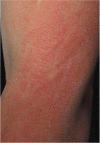Mastocytosis: a disease of the hematopoietic stem cell
- PMID: 19623287
- PMCID: PMC2696962
- DOI: 10.3238/arztebl.2008.0686
Mastocytosis: a disease of the hematopoietic stem cell
Abstract
Introduction: Mastocytosis is an unusual clonal disease of the hematopoietic stem cell.
Methods: This article is based on a selective literature search and on the authors' clinical and pathological experience.
Results: The clinical manifestations of mastocytosis range from cutaneous mastocytosis, a common, prognostically favorable presentation, to mast cell leukemia, a rare, life-threatening disease. The mediator-induced symptoms usually respond well to H1 antihistamines. Therapeutic standards for cytoreduction in the progressive, systemic forms of mastocytosis are still lacking.
Discussion: Because some of the manifestations of mastocytosis are nonspecific and can be mimicked by other diseases, there is a risk of two types of diagnostic error: Mastocytosis may remain undiagnosed when it is actually present, or it may be diagnosed even though morphological and molecular findings rule out mastocytosis. Well-defined criteria should be used to differentiate mastocytosis from other diseases with a similar clinical presentation.
Keywords: anaphylactic reaction; diagnosis; differential diagnosis; mastocytosis; urticaria.
Figures







Comment in
-
Re: Mastocytosis--a disease of the hematopoietic stem cell. Problematic criteria.Dtsch Arztebl Int. 2009 Mar;106(10):173; author reply 173-4. doi: 10.3238/arztebl.2009.0173. Epub 2009 Mar 6. Dtsch Arztebl Int. 2009. PMID: 19578396 Free PMC article. No abstract available.
References
-
- Ehrlich P. Beiträge zur Kenntniss der granulierten Bindegewebszellen und der eosinophilen Leukocythen. Arch Anat Physiol. 1879;3:166–169.
-
- Hartmann K, Henz BM. Mastocytosis: recent advances in defining the disease. Br J Dermatol. 2001;144:682–695. - PubMed
-
- Valent P, Horny H-P, Li CY, et al. World Health Organization (WHO) classification of tumors. Mastocytosis (mast cell disease) In: Jaffe ES, Harris NL, Stein H, Vardiman JW, editors. Pathology and genetics of tumors of haematopoietic and lymphoid tissues. Lyon: IARC Press; 2001. pp. 291–302.
-
- Valent P, Horny H-P, Escribano L, Longley JB, Li CY, Schwartz LB, et al. Diagnostic criteria and classification of mastocytosis: a consensus proposal. Conference report of „Year 2000 Working Conference on Mastocytosis“. Leuk Res. 2001;25:603–625. - PubMed
LinkOut - more resources
Full Text Sources

